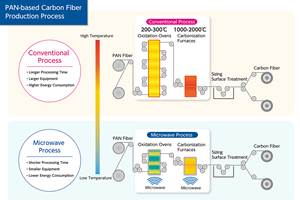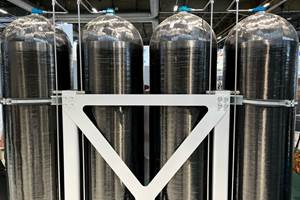SPE ACCE scholarship winners announced
The winners are Markus Downey of Michigan State University, Fatimat Oluwatoyin Bakare of University of Borås and Sebastian Goris of University of Wisconsin-Madison.
The organizing committee for the SPE (Troy, Mich., USA) Automotive Composites Conference & Exhibition (ACCE, Sept. 9-11, 2014) has announced the winners of the group’s annual SPE ACCE Scholarship Awards for the 2014-2015 academic year. Winning students whose composites-intensive projects were judged to have the greatest potential impact on ground transportation were Markus Downey of Michigan State University, Fatimat Oluwatoyin Bakare of University of Borås and Sebastian Goris of University of Wisconsin-Madison. Each student will receive a total scholarship of $2,000 USD ― sponsored by Michigan Economic Development Corp. (Lansing, Mich.) ― and will return to present the results of his or her research at next year’s SPE ACCE show, Sept. 9-11, 2015.
Markus Downey, who is working on a Ph.D. degree in Chemical Engineering at Michigan State University (East Lansing, Mich., USA), won the scholarship for a student enrolled in a Michigan institute of higher learning with the topic: Hybrid Toughening of Aromatic Epoxy Polymers via Graphene Nano-Platelets and Aliphatic Epoxy Copolymers: Optimized Fiber-Reinforced Polymer Composites for Lightweighting. Explaining how his work is applicable to ground transportation Downey says, "Fiber-reinforced polymer composites will play a significant role in the lightweighting strategies required to meet the new U.S. Corporate Average Fuel Economy (CAFE) standards. My proposed research will look at hybrid-toughening of fiber-reinforced polymer composites by toughening the fiber/matrix interface with aliphatic epoxy co-polymers alone or in conjunction with graphene nanoplatelets as well as toughening the bulk matrix with low concentrations of aliphatic epoxy co-polymers ― two typical areas of failure in fiber- reinforced polymer composites. Through targeted improvements of both the sizing (coating) on the reinforcing fibers and the surrounding polymer matrix, the energy required to propagate cracks in each of these areas should be increased to yield a substantially toughened composite. This, in turn, can help reduce the amount of material needed for a given application, leading to weight and cost savings, or it can possibly broaden usage in new areas of the vehicle, particularly if the composite shows mechanical properties not previously attained."
Originally from Nigeria and currently working on her Ph.D. degree in Materials Science/Polymer Engineering at the Swedish Centre for Resource Recovery at the University of Borås (Borås, Sweden), Fatimat Oluwatoyin Bakare won a scholarship for her proposal on Synthesis of Bio-Based Composites with a Lactic Acid Based Thermoset Resin from Lactic Acid and Allyl Alcohol. Explaining how this work is important for the transportation industry Bakare says, "There have been increased interests in the use of biomass and its derivatives to provide alternatives to fossil fuel resources to reduce environmental risks and improve global sustainability. Biomass and its derivatives can be used in the production of polymer and composite materials, leading to weight loss and gains in fuel efficiency. We have previously reported synthesis of a thermosetting bio-based resin prepared by direct condensation of pentaerythritol, itaconic acid, and lactic acid. This resin had relatively good mechanical properties, but its relatively high viscosity caused poor wetout and impregnation of reinforcements, leading to lowered mechanical performance. Hence, a new resin with lower viscosity that would provide better impregnation of reinforcements is needed. The goal of my new research is to investigate the technical feasibility of a resin based on lactic acid and allyl alcohol combined with natural fiber reinforcement."
Originally from Germany, Sebastian Goris is working on a doctorate degree in Mechanical Engineering at University of Wisconsin-Madison (UWM, Madison, Wis., USA) and won the third graduate scholarship this year with a research project entitled Contribution to the Understanding of Fiber Motion in Compression Molding of Long-Fiber Thermoplastics. Explaining the significance of his topic Goris says, "Compression molding of long fiber- reinforced thermoplastics (LFT) composites is a widely used process to produce semi-structural parts with a desirable balance of low weight, good mechanicals, and cost-efficient manufacturing. However, the final state of the fibers greatly impacts the local and global properties of the finished part and has to be carefully considered, although currently there is no software tool able to predict fiber-matrix separation and fiber dispersion within a molded part. In our group, a mechanistic model has been developed that represents each fiber as a chain of interconnected segments and takes into account excluded volume forces, drag forces, fiber- fiber interactions, and fiber elasticity. For my research, I will introduce this model for an extensive study on fiber attrition, fiber dispersion, and fiber-matrix separation in LFT compression molding. Simulation results will be verified to aid in the understanding of fiber- fiber and fiber-matrix interactions. A more accurate prediction of the anisotropy and heterogeneity within compression-molded LFT parts will provide the foundation for reliable structural analysis and hence automotive part design."
Held annually in suburban Detroit, the SPE Automotive Composites Conference & Exhibition draws over 900 speakers, exhibitors, sponsors, and attendees and provides an environment dedicated solely to discussion and networking about advances in the transportation composites.
Related Content
Watch: A practical view of sustainability in composites product development
Markus Beer of Forward Engineering addresses definitions of sustainability, how to approach sustainability goals, the role of life cycle analysis (LCA) and social, environmental and governmental driving forces. Watch his “CW Tech Days: Sustainability” presentation.
Read MoreHexagon Purus Westminster: Experience, growth, new developments in hydrogen storage
Hexagon Purus scales production of Type 4 composite tanks, discusses growth, recyclability, sensors and carbon fiber supply and sustainability.
Read MoreMicrowave heating for more sustainable carbon fiber
Skeptics say it won’t work — Osaka-based Microwave Chemical Co. says it already has — and continues to advance its simulation-based technology to slash energy use and emissions in manufacturing.
Read MoreRecycling hydrogen tanks to produce automotive structural components
Voith Composites and partners develop recycling solutions for hydrogen storage tanks and manufacturing methods to produce automotive parts from the recycled materials.
Read MoreRead Next
VIDEO: High-volume processing for fiberglass components
Cannon Ergos, a company specializing in high-ton presses and equipment for composites fabrication and plastics processing, displayed automotive and industrial components at CAMX 2024.
Read MorePlant tour: Daher Shap’in TechCenter and composites production plant, Saint-Aignan-de-Grandlieu, France
Co-located R&D and production advance OOA thermosets, thermoplastics, welding, recycling and digital technologies for faster processing and certification of lighter, more sustainable composites.
Read MoreDeveloping bonded composite repair for ships, offshore units
Bureau Veritas and industry partners issue guidelines and pave the way for certification via StrengthBond Offshore project.
Read More














.jpg;maxWidth=300;quality=90)










